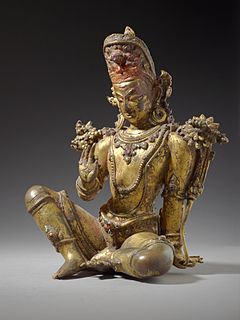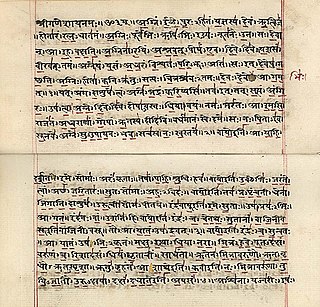Related Research Articles

Aditi Sanskrit: अदिति, lit. 'boundless' or 'limitless' or 'innocence') is singlehandedly the most influential and important Vedic goddess in Hinduism. She is the personification of the sprawling infinite and vast cosmos. She is the goddess of the earth, sky, unconsciousness, the past, the future and fertility. She is the mother of the celestial deities the Adityas, and is referred to as the mother of many gods. As celestial mother of every existing form and being, the synthesis of all things, she is associated with space (akasa) and with mystic speech (Vāc). She may be seen as a feminized form of Brahma and associated with the primal substance (mulaprakriti) in Vedanta. She is mentioned more than 250 times in the Rigveda, out of praise, admiration, and respect.

The Maruts, also known as the Marutagana and sometimes identified with Rudras, are Vedic storm deities and sons of Rudra and Prisni. The number of Maruts varies from 27 to sixty. They are very violent and aggressive, described as armed with terrific weapons i.e. lightning and thunderbolts, as having iron teeth and roaring like lions, as residing in the northwest, as riding in golden chariots drawn by quick moving ruddy horses.
Savitṛ in Vedic culture is an Aditya i.e. off-spring of the Vedic primeval mother goddess Aditi. His name in Vedic Sanskrit connotes "impeller, rouser, vivifier."

Atri or Attri is a Vedic sage, who is credited with composing numerous hymns to Agni, Indra and other Vedic deities of Hinduism. Atri is one of the Saptarishi in the Hindu tradition, and the one most mentioned in its scripture Rigveda.
Parjanya according to the Vedas is a deity of rain, thunder, lightning, and the one who fertilizes the earth.

Gayatri is the personified form of Gayatri Mantra, a popular hymn from Vedic texts. She is also known as Savitri and Vedamata. Gayatri is often associated with Savitr, a solar deity in the vedas. According to many texts like the Skanda Purana, Gayatri is another name of Saraswati or her form and is the consort of Lord Brahma. However, Saivite texts identify Mahagayatri as the consort of Shiva, in his highest form of Sadasiva with five heads and ten hands.

Deva means "heavenly, divine, anything of excellence", and is also one of the terms for a deity in Hinduism. Deva is a masculine term; the feminine equivalent is Devi.
The Visvedevas are the various Vedic gods taken together as a whole. In the Rigveda a number of hymns are addressed to them, including 1.89, 3.54-56, 4.55, 5.41-51, 6.49-52, 7.34-37, 39, 40, 42, 43, 8.27-30, 58, 83 10.31, 35, 36, 56, 57, 61-66, 92, 93, 100, 101, 109, 114, 126, 128, 137, 141, 157, 165, 181.
The eighth Mandala of the Rigveda has 103 hymns. Other than the "family books" and RV 1 and RV 10, Mandala 8 cannot straightforwardly be dated as a whole relative to the other books, and its hymns may include both ancient and late specimens. Most hymns in this book are attributed to the kāṇva family. The hymns 8.49 to 8.59 are the apocryphal vālakhilya, the majority of them are devoted to Indra; these are accepted as a recent portion, properly already post-Rigvedic.
The first Mandala ("book") of the Rigveda has 191 hymns. Together with Mandala 10, it forms the latest part of the Rigveda. Its composition likely dates to the late vedic period or the Early Iron Age.
The second Mandala of the Rigveda has 43 hymns, mainly to Agni and Indra chiefly attributed to the Rishi gṛtsamada śaunohotra. It is one of the "family books", the oldest core of the Rigveda, which were composed in early vedic period(1500-1000 BCE).
The third Mandala of the Rigveda has 62 hymns, mainly to Agni and Indra. It is one of the "family books", the oldest core of the Rigveda, which were composed in early Vedic period. Most hymns in this book are attributed to viśvāmitra gāthinaḥ
The fourth Mandala of the Rigveda has 58 hymns, mainly to Agni and Indra. It is one of the "family books", the oldest core of the Rigveda, which were composed in early vedic period(1500-1000 BCE).
The sixth Mandala of the Rigveda has 75 hymns, mainly to Agni and Indra. Most hymns in this book are attributed to the bārhaspatya family of Angirasas, especially to Bharadvaja. It is one of the "family books", the oldest core of the Rigveda, which were composed in early vedic period(1500-1000 BCE).
The seventh Mandala of the Rigveda has 104 hymns. In the Rigveda Anukramani, all hymns in this book are attributed to Vashista. Hymn 32 is additionally credited to Sakti Vashista, and hymns 101-102 are additionally credited to Kumara Agneya. It is one of the "family books", the oldest core of the Rigveda, which were composed in early vedic period(1500-1000 BCE).
The ninth Mandala of the Rigveda, also called the Soma Mandala, has 114 hymns, entirely devoted to Sóma Pávamāna, "Purifying Soma", the sacred portion of the Vedic religion. Similar to Mandala 8, it cannot be dated within the relative chronology of the Rigveda as a whole; dealing with the Soma cult, a practice reaching back into Proto-Indo-Iranian times, some of its hymns may contain the very oldest parts of the Rigveda, while other hymns may be rather recent relative to the other books. As with book 8, each hymn should be studied independently, since the Soma Mandala was not compiled by the redactors in its preserved form on grounds of authorship or clan affiliation, but topically, grouping the Soma hymns.
There are 1,028 hymns (sūkta) in the Rigveda, the principal text of the historical Vedic religion of the Vedic period. Most of these hymns are dedicated to specific deities. The most prominent deity is Indra, slayer of Vritra and destroyer of the Vala, liberator of the cows and the rivers; Agni the sacrificial fire and messenger of the gods; and Soma, the ritual drink dedicated to Indra, are additional principal deities.
Mitra is a divinity of Indic culture, whose function changed with time. In the Mitanni inscription, Mitra is invoked as one of the protectors of treaties. In the Rigveda, Mitra appears primarily in the dvandva compound Mitra-Varuna, which has essentially the same attributes as Varuna alone, e.g. as the principal guardian of ṛtá "Truth, Order". In the late Vedic texts and the Brahmanas, Mitra is increasingly associated with the light of dawn and the morning sun. In the post-Vedic texts – in which Mitra practically disappears – Mitra evolved into the patron divinity of friendship, and because he is "friend", abhors all violence, even when sacred.

The Rigveda or Rig Veda is an ancient Indian collection of Vedic Sanskrit hymns (sūktas). It is one of the four sacred canonical Hindu texts (śruti) known as the Vedas.

The Devi Upanishad, is one of the minor Upanishads of Hinduism and a text composed in Sanskrit. It is one of the 19 Upanishads attached to the Atharvaveda, and is classified as one of the eight Shakta Upanishads. It is, as an Upanishad, a part of the corpus of Vedanta literature collection that present the philosophical concepts of Hinduism.
References
- ↑ Gurupriya, P. A treatise on the Vedas. Chennai: Kadalangudi Publications.
- ↑ Dahiya, Poonam Dalal (2017-09-15). ANCIENT AND MEDIEVAL INDIA EBOOK. McGraw-Hill Education. p. 95. ISBN 978-93-5260-673-3.
- ↑ Shukla, Sidh Nath (2001). The Rigveda Mandala: v. III: A Critical Study of the Sayana Bhashya and Other Interpretation. India: Sharada Books. ISBN 8185616736.